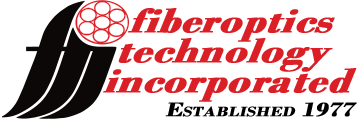FTI manufactures glass and plastic photoelectric light guides as an aftermarket service sold from stock. We also work directly with customers as an OEM supplier.

For some types of sensing applications, fiber optic components are used to transmit and receive a light signal, carrying the signal back to a photoelectric sensor which in turn, actuates an electric control. The overall process senses and reacts to a dramatic change in light intensity to confirm the absence/presence/position of an object.
Fiber optic components protect photoelectric sensors (from heat and harsh environments) and facilitates their use in space-restrictive areas. They may also be used to isolate vibration, keeping the sensor stable in continuous motion applications.
Because the active area of the fiber bundle can be “shaped” to match the profile of the object being sensed, they help improve the accuracy of photoelectric controls.
Application potential is extensive. Some special applications, such as high temperature, high vacuum and wet/corrosive environments require additional processing to be effective.
In this page, we describe a complete fiber optic component as a “cable”. They are also referred to as light guides and light pipes.
Fiber optic cables may be made from plastic or glass fibers. Glass cables can transmit infrared wavelengths, and will withstand harsh environments better. Plastic cables have better resistance to fatigue in constant motion applications, and may be less expensive to produce.
COMPONENT DESIGN
The length of most standard fiber optic cables for photoelectric control is 36”; although custom applications can be developed which offer custom lengths. The standard configurations for all fiber optic photoelectric cables are single (for opposed applications) or dual (bifurcated) for reflective applications.
The common end (bottom leg of a “Y”) of a dual (bifurcated) light cable is the leg pointed at the object being sensed, and is called the distal end. Distal end configurations for single and bifurcated light guides are typically threaded to aid in mounting the end to an alignment fixture. Because fiber optic cables are typically used in space constrained areas, a broad range of distal end configurations are offered. Straight, 45 degree, and 90 degree bends in the distal end are standard.
The active fiber diameter of most light cables is .125 with .062 and.156 offered as options. The fiber configuration is typically round. Slit (rectangle) shapes are also specified.
Lenses are sometimes provided to help collect light, which extends the effective range of the sensing component.
PVC covered monocoil, and SS interlock sheathing are standard sheathing types.
The end(s) of the light cable attached to the sensor and/or emitter is called the Proximal end. Because the fiber optic component mates to so different sensor designs, a selection of proximal end tips are available.
FTI manufactures components for after-market replacement or initial installation of all major sensor manufacturers, including Omron, SunX, Tritronic, Allen Bradley, Cutler Hammer, ABB, and others.
Here is a summary of FTI’s photoelectric control cable product specifications:
- Fiber diameter .0018 (30 micron), .002 (50 microns), .0028 (70 micron) (other diameters available upon request)
- Core-to-clad ratio 90% of core and 10% of clad nominal
- Temperature range -50°F (-45°C) to 525°F (275°C). High temperature of 825°F (440°C) available
- Minimum bend radius 2.5 x sheathing O.D.
- Chemical stability – transmission is unaffected by water, gasoline, engine oil, sulfuric acid and other organic acids
- Numerical aperture .25, .37, .55, .66, and .83
- Acceptance angle from 17° to 160°
- Length – up to 60 feet
- Active bundle diameters up to 2.0” (25.4 mm
- End-fittings – stainless steel, aluminum, brass or plastic
- Sheathing – pvc/monocoil, flexible pvc (no monocoil), flexible interlocking stainless steel, silicone and neoprene (fluorocarbon rubber and hermetically sealed teflon
- available upon request)
- Tapers and rod – Clad white light carrying rigid optical rod Coherent imaging fused rod, maximum fiber packing results in optimum output and image transfer. Taper to help manage light collection or focus.
Below are descriptions of 20 of the most popular models. If you can’t find what you need in the list below, contact us to describe the component you would like to order.
Our P/N Matrix in the tables below describe each pictured configuration.

